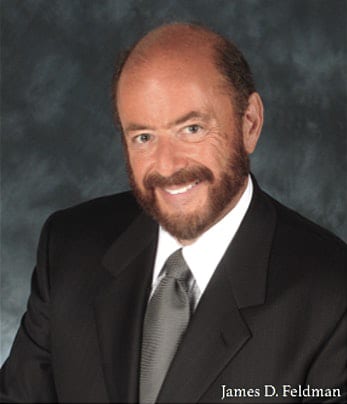This is an example of an article written by Jim Feldman for a publication or newsletter. Jim is an author, keynote speaker and consultant who writes and speaks about Change Management, Customer Service and Innovative Problem Solving. Contact us about using Jim as an author, interview or speaker at 312-527-9111.
As we reach the end of the summer, most of us realize that we didn’t relax as much as we had planned. We did not enjoy the soft summer breeze, smell the flowers, or even walk along the beach or pathway to make new discoveries. We have less time to enjoy our life because we are living to work instead of working to live.
My newsletters give me a time to reflect on my life. At least twice a month, I look around and ask, What If? This has provided me with insights and direction that I had as a child. Kids have learned to handle change. They take it in stride. They enjoy it. They bend. They love variety. We need to act like children again and create a culture that knows how to learn.
I now think “inside the box” because that is where the “present” is found. I wander into stores I never visited; I sit on park benches and watch pigeons fighting over morsels of food. I look around and observe life and try to find how I can benefit from what I observe.
And most importantly, I watch how others interact. I see the massive mistakes that any child would avoid, but adults not only create but also embellish when challenged. We don’t have time to do it right, but always find time to do it over. We create budgets and processes and find excuses for why we don’t adhere to our own creations. Better Change.
Remember, culture can be very controlling. However, no matter how strong, culture cannot change without permission from the people. . .you shape it by how you behave. Every single thing you do serves as one more building block that makes up the personality – the culture – of your organization.
Problems occur when the world changes but the culture can’t, because the people in the organization won’t give it a chance. Successful people embrace change. Change relies on you to give it a new set of responses that holds more promises for the future. Better Change.
Every company has a brand image. It is the message that we receive when we purchase and use products and services. It is how we respond to the changing world and tell others of our experiences. What about your brand? Remember it is YOUR brand. It is how others think of you as well as your company. Don’t assume that the two are separate. They are unavoidably linked. Is it time to change your tune? Is it time to Strike Up Your Brand? Better Change.
Perhaps the world is changing?
After a grueling business trip from Chicago to New Orleans, New Orleans to Phoenix, Phoenix to Los Angeles, a drive to Pomona, and a red eye flight from Los Angeles to Chicago, I have some good news. . .the travel experience was refreshingly pleasant.
I used frequent miles to fly from Chicago to New Orleans on US Air. With all of my criticism of the big airlines, they are wonderful compared to US Air. Without going into the details, US Air’s level of service is so far below American Airlines I will stop complaining about AA, because at least they try. US Air simply was misinformed and at every contact provided an attitude of “it is not my problem,” no matter the question.
Upon comparison I must commend AA for their efforts. While I don’t agree with everything they do or the policies they have created, they do represent a Better Change.
On this trip I stayed in four hotels, flew on three airlines, and found six of the seven travel experiences conveying Better Change. Employees expressed concern and offered real time solutions.
The most amazing situation occurred when I discovered that my luggage was sent to Chicago when I was awaiting its arrival in LA. I spoke to the Red Carpet Club Concierge and she tracked down my bag. Her research confirmed that my luggage had been sent to Chicago instead of being off loaded for my stop in LA. She took time, called to confirm, and then printed out the response so I had a record of her discovery. Clearly she did everything she could to help locate my luggage.
(The bag, I found out, had been at Chicago’s O’Hare airport, unattended on the baggage area floor for over 12 hours. All of us who travel hear the plea from the loudspeaker, DO NOT LEAVE YOUR BAG UNATTENDED. . .IT WILL BE CONFISCATED. What happened to our TSA security? What about the local police?)
While I was relieved that the bag was found, it was severely damaged. It was held closed only by the Velcro straps that offered secondary closure. The frame was bent, the locks broken, one wheel torn from its riveted housing and the contents totally in disarray.
I took the crippled bag to the United Baggage Service Center. It was 12:15 a.m. and I fully expected to find no one there. To my surprise, two women greeted me and listened to my plight. They both pointed to the plaque on the wall that said, Loss of wheels was normal wear and tear. It went on to list all of the other reasons that United was not liable.
Here’s the amazing part. . .after I explained that I didn’t agree, without further discussion the two ladies from UNITED became Friendly. . .not in the Skies, but on the Ground. They asked me to wait and went through a secured door. Within a few minutes they emerged with a brand new bag. They offered me a choice of having my damaged bag repaired or take the new, unused, quality replacement.
How easy was that choice? How empowered were they to make a bad situation better? They took a frustrated, tired passenger and renewed my belief that customers like it best when you are an innovative provider of solutions. What did you do today to make your customers happy? Were you a solution instead of another problem?
In the past, change required a slower response time. Today, in a world of high velocity, change requires radical SHIFTS in behavior. Responses must be in real time. Specifically, we must think differently. We must reorder our priorities. We must face reality and do what works best. Better Change.
Two early morning agents were empowered to solve a problem and create a satisfied customer. The extra effort was appreciated and helped me to regain my belief that shifts do happen and all shifts are not bad. Let’s celebrate and Strike Up The Brand. . .friendly agents do exist.
As you head off for a long Labor Day weekend, take a few moments to plan how you will change your business relationship with your customers, employees and suppliers. Here are a few ideas that will help you Strike Up Your Brand.
Better Change: Shift Perspective
Leaders must focus from tasks to processes. The old way of looking was narrow, looking at a department or function. Today we must view the process outcomes. We must know that a market exists for our product or service innovation.
Manage the shifts in your organization. Build an intelligent perspective or process that can be utilized and understood. Explain how jobs will change. Discuss the outcomes of change. Reward for achievement.
Better Change: Shift Direction
Without a creative direction, few organizations will survive in a changing environment. As managers, we must provide what the customer wants, not what the factory makes. We must serve the customer. Internal customers (employees and suppliers) are as important as the external one. Create processes that integrate the two.
The organization is only as effective as the processes. Poor direction causes poor performance. If you match a valuable performer with a poor policy, the policy will win. Make each person accountable for customer satisfaction. Make sure that everyone is committed. Better Change: Shift Commitment.
Successful entrepreneurial organizations DATE their customers. They DAZZLE them. They ANTICIPATE their needs. They TREAT their employees and suppliers as well as they treat their customers. They EDUCATE customers, employees and suppliers. Why? Because everyone needs their wisdom.
Customer service is not a department, it is an ATTITUDE. The actual needs of your customers, not just the needs you imagine they have, must influence everything your organization does. Focus everyone on exceeding customer expectations. Customers run the business. Stay connected to your customer.
Better Change: Shift Failure
We must create a safety zone for failure. A shift in learning usually means we learn through trial and error, which means being able to accept the fact that everything won’t work. A failure can often open the door to another idea that will be successful. We must allow for failure without penalty. If the penalty for failure is too high, no one will try anything new.
Ask associates how they would apply their skills if they were the owner, not the worker. People want to be measured. It is a basic human need. We want to be told how we are doing, to be reassured, especially during times of shift in any organization. Poor performers don’t like measurements. Perhaps that requires a shift in the people resources.
Better Change: Shift Happens!
Bill Gates, in Business @The Speed of Thought, says, “A lousy process will consume ten times as many hours as the work itself requires. A good process will eliminate wasted time.”
Realize that some entrepreneurial concepts may not be accepted or appreciated all the time. Timing is everything. Be willing to shift your timetable. “Know when to hold them, know when to fold them, know when to walk away, and know when to run,” says Kenny Rogers’ The Gambler. Get rid of all those cards that prevent you from winning. We can see “losing hands” in the cards we hold. Replace them.
Shift Happens: Change keeps picking up speed. Before we can adjust to one change several others take place. We are all living in a constant period of transition, and the shelf life of your solutions keeps getting shorter. New problems require new solutions. If you fail to SHIFT with the SHIFTING conditions, you’ll be off the mark.
The best way to improve your business relationships is to partner in the expansion of people’s minds. Create education strategies and use the most powerful technologies available.
Can the opportunities to grow your business be any more exciting than this? Is it possible that the skies will become more friendly and airlines will truly understand why we fly? If there is a time for change. . .it is now.
Nissan has Shifted Gears. Toyota thinks its just “Good Business”. . .and Nike tells us to “Just do it.” Now it’s your turn to Strike Up The Brand of your own company. Better Change.






